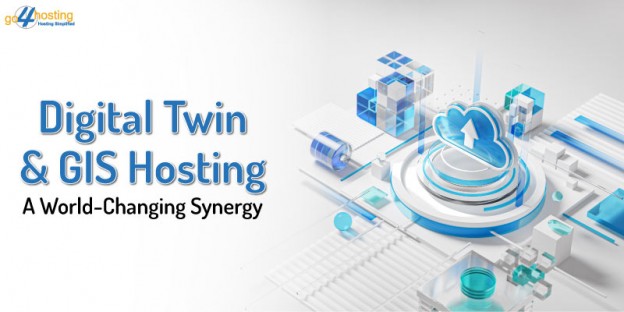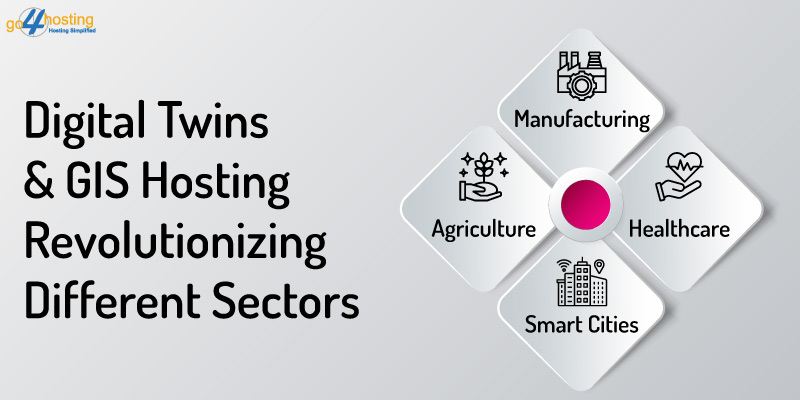Table of Content
The parallel of Digital Twin Technology and GIS Cloud Hosting is a revolution that brings a new dimension to the world. Think about a digital copy of a physical element with the same features that reflect its behavior in real time – a digital twin. Now, pair this with Geographic Information System (GIS) hosting, a robust spatial data management and analysis platform. The result? A dynamic synergy poised to revolutionize industries worldwide.
As per Allied Market Research, the digital twins have gathered notable momentum across industries, with an expected market value of around $125.7 billion by 2030. From optimizing production processes to smart cities enhancing urban planning, they are game changers. It is especially true for organizations with the unprecedented power of insights and predictive capabilities.
Meanwhile, GIS hosting serves as the backbone of a spatial data infrastructure. It allows organizations to visualize, analyze, and interpret geospatial data efficiently. It has become a significant subject with over 1.6 million GIS professionals globally and the ever-increasing demand for spatial data analytics. GIS hosting is vital in agriculture, transportation, and environmental management.
The symbiotic relationship between digital twins and GIS hosting propels us toward a future where data-driven insights drive transformative change.
How do Digital Twins and GIS Hosting Complement Each Other?
Digital twins and Geographic Information System (GIS) hosting complement each other in diverse ways. It offers a powerful combination for managing and analyzing complex systems. Let’s have a quick look at a few of them:
Enhanced Visualization and Analysis
Geospatial and non-geospatial data analysis can provide organizations with better visualization and GIS hosting by combining it with digital twins. It is the basis of good decision-making and the source of operational efficiency.
Use in Urban and Natural Systems
The combination of digital twins and GIS hosting is particularly valuable for cities, natural systems, and complex infrastructure. It enables the creation of detailed, interactive models. These models can be used for urban planning, environmental management, and infrastructure maintenance.
Cognitive Digital Twins
Moreover, the development of cognitive digital twins is one of the most promising research areas. These cognitive digital twins merge BIM-GIS (Building Information Modeling and Geographic Information Systems) systems to tackle complex infrastructure and systems, such as university campuses.
The combination of digital twins and GIS hosting is particularly valuable for cities, natural systems, and complex infrastructure. It enables the creation of detailed, interactive models that can be used for urban planning, environmental management, and infrastructure maintenance.
How is the Synergy between Digital Twins and GIS Hosting Revolutionizing Different Sectors?
The synergy between digital twins and GIS hosting is digitizing different sectors. It enables organizations to make informed decisions, optimize operations, and improve efficiency across different sectors.
Manufacturing
Digital twin facilitated by GIS-hosted gives a virtual interpretation of physical assets and systems in the manufacturing sector. This integration allows for real-time monitoring, predictive maintenance and performance improvement. For example, digital twins can provide data about equipment operation, energy consumption, and production processes. It might result in better performance, reduced costs and operational efficiency.
Healthcare
The benefits of digital twins in conjunction with GIS hosting systems in the healthcare sector are outlined to improve service delivery and management of facilities. Digital twins are a concept that can be used to create virtual models of healthcare facilities. It will help effectively utilize space, resource allocation, and emergency planning. Integrating geospatial data enables healthcare organizations to optimize facility layout, improve patient flow, and enhance operational effectiveness.
Smart Cities
Integrating digital twins and GIS hosting is revolutionizing urban planning and management. Integration of various data sources, such as geographical information systems and remote sensing, with advanced visualization and modeling techniques, allows for the creation of highly detailed and interactive models of cities. Thus facilitating better decision-making in fields like infrastructure development, environmental management, and resource optimization. For example, digital twins linked with spatial data can model traffic flows and improve public transport routes. Moreover, it shapes sustainable urban development. This merging leads to innovation and higher quality of life in the urban areas.
Agriculture
Digital twins supported by GIS hosting enhance smart farming practices in agriculture. Farmers can virtualize their farms and integrate geospatial data onto their virtual farms to formulate models that optimize crop planning, irrigation, and management. Such integration enables the farmers to make data-informed decisions, fine-tune their operations, and ultimately ensure the sustainability of their cultivation. Digital twins have become a tool of significant strength for farmers in the eyes of farmers to boost and enhance the productivity of their farming activities.
The digital twins and GIS hosting alliance is revolutionizing several sectors. It leads to higher operational efficiency, better decision-making, and increased resource management. This integration drives innovation and revolutionizes how organizations manage and optimize complex systems across different sectors.
Synergy Between GIS Hosting and Digital Twin: Potential Challenges
Some potential challenges in implementing the synergy between GIS hosting and digital twin include:
Data Quality
Data accuracy is a major component of digital twins. Data quality management is critical as the digital twin’s accuracy and reliability directly depend on the quality of the data. Another issue is validating the data imported into the digital twin from the GIS hosting by its accuracy, timeliness, and consistency.
Security
The security of the data integrated into the digital twin from GIS hosting is a major concern. As digital twins usually contain important and sensitive data, the security and integrity of the data have been an issue of great concern throughout the entire lifecycle, and an excellent solution to the problem is seriously needed.
Interoperability
Ensuring compatibility among the various GIS hosting systems and combined data sources to create the digital twin can sometimes be challenging. Standards, protocols, and data formats must be harmonized to ensure uninterrupted exchange and integration. It requires thorough planning and coordination.
Scalability
With the rise in complexity and scope of digital twins, integrating systems’ scalability, including GIS hosting, becomes a challenge. The scalability of storing large amounts of data, handling the growing number of connected devices, and accommodating the changing requirements is critical for the long-term success of digital twin projects.
How to Overcome These Challenges?
To overcome the challenges in implementing the synergy between GIS hosting and digital twin, several strategies can be employed:
Data Quality
- Implement data quality management processes to ensure the data integrated from GIS hosting into the digital twin is accurate, up-to-date, and consistent.
- Apply data validation and cleaning methods to pinpoint and fix any errors or discrepancies in the joined data.
Security
- Implement data security measures such as encryption, access controls, and monitoring to protect the data integrated from GIS hosting to the digital twin.
- Follow the industry’s best practices and data security and privacy regulations to handle the risks related to sensitive and critical data in the digital twin.
Interoperability
- Establish a unified standard for the data formats, protocols, and interfaces. It guarantees smooth integration and exchange between the digital twin, hosting GIS and other systems and data sources.
- Utilize interoperability frameworks and technologies to harmonize data sources and systems connected to the digital twin.
Scalability
- Develop the digital twin and GIS hosting flexible architecture to process large data volumes. It will support the growing number of connected devices and accommodate changing requirements.
- Use cloud-based solutions and technologies that are scalable and flexible to provide the necessary support for the complexities and scope of digital twins and GIS hosting.
My Two Cents
Integrating digital twin and GIS hosting will create a path for a massive transformation in several industries. Organizations can gain previously unseen insights, maximize their performances, and foster innovation by leveraging virtual avatars’ power and implementing high-quality spatial data management and analysis systems. The combination of digital twins and GIS hosting brings about a paradigm shift in our approach to managing and optimizing complex systems in diverse industries such as manufacturing, healthcare, smart cities, and agriculture.
Start taking the next step towards the digital twin and GIS hosting transformation. Contact Go4hosting today to learn more about their full-spectrum GIS hosting services and take your organization to the future with data-oriented decision-making.






 Live Chat
Live Chat

